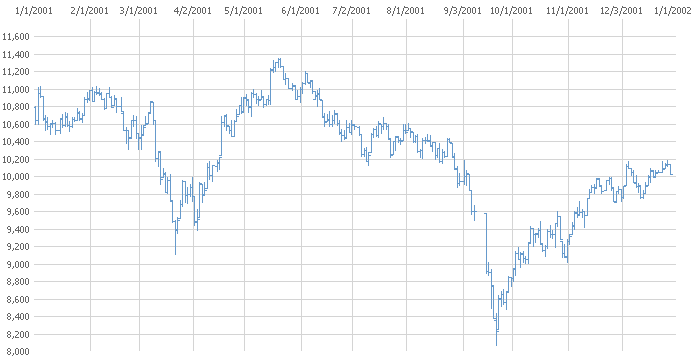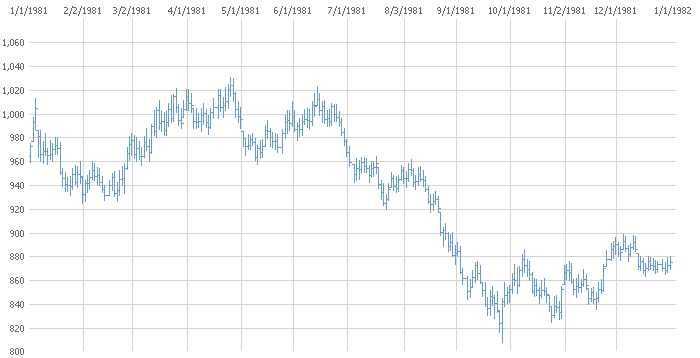Stock Market Cycles Analysis
Stock-Markets / Stock Markets 2011 Jun 05, 2011 - 06:39 AM GMTBy: Clif_Droke
 Let’s take a step back and examine the intermediate-term outlook for 2011 based on some observations we made earlier this year.
Let’s take a step back and examine the intermediate-term outlook for 2011 based on some observations we made earlier this year.
Earlier we discussed the outlook for 2011 based on an “echo analysis” of the Kress cycles. In January, Ned Davis Research produced a chart which combined the stock market’s 1-year, 4-year and 10-year tendencies. This composite chart suggested that most of this year’s gains will occur in the first half of the year. Our own composite work based on the Kress cycle “echo” phenomenon also suggested that the stock market could make a significant peak in the April-May time frame and that most of the market’s gains would be made in the first half of 2011.
The Kress cycle “echo” effect is a composite of the 6-year, 10-year, 30-year and 60-year cycles. Using 2011 as the starting point we go back 6 years to 2005, 10 years to 2001, 30 years to 1981 and 60 years to 1951 to arrive at the composite “road map” for the stock market. This provides us with only a rough approximation of what could happen and shouldn’t be used as an absolute guideline since no two markets are ever exactly alike. These cyclical tendencies are worth noting, however, since they do tend to show the same tendencies during the echo years mentioned above.
In the Feb. 4 report we did an in-depth echo analysis in which we looked at the 6-year cycle going back to 2005, the 10-year cycle going back to 2001, the 30-year cycle back to 1981, and the 60-year cycle back to 1951. We concluded that the February-March time frame tends to be a rally period for the stock market with April being a “blow off” or peak month. We found that in the previous “echo” periods of the analysis that the market had a tendency to post interim peaks in late April or early May.
For instance, going back to the year 1951 we found that the stock market posted an interim peak in the early part of May that year in keeping with the common theme of all four years. In the 30-year echo year of 1981 the market’s final peak was made at the end of April. In the 10-year echo year of 2001 the market’s peak was in mid-May.
In the Feb. 4 report we wrote, “There are two conclusions that can be made from this echo analysis of the four key Kress cycles. The first is that the stock market tends to rally in February with a significant short-term peak in March. The second conclusion is that a significant intermediate-term top tends to occur in the May time frame.” Also in the Feb. 4 report it was noted that Ned Davis Research had produced a chart which combines the stock market’s 1-year, 4-year and 10-year tendencies. This composite chart suggested that most of this year’s gains will occur in the first half of the year.
With the benefit of hindsight we can see that this echo analysis proved itself useful in predicting the late April/early May top this year. There was a tradable rally in February with a correction March, followed by another significant peak at the start of May. So far the Kress cycle “echo analysis” has proven to be reasonably correct in predicting the first five months of 2011. The question we want to examine tonight is what the second half of 2011 will likely show based on the Kress cycle echoes.
To answer this question it will help us to once again go back and examine the stock market chart patterns from the key years 2005 (6-year cycle), 2001 (10-year cycle), 1981 (30-year cycle) and 1951 (60-year cycle). Once we’ve done this we can average out the patterns to form a composite for what the second half of 2011 might look like. By way of disclaimer, please keep in mind that “markets and snowflakes are never exactly the same,” so this is only a rough approximation and should be used as an absolute rule by itself.
Before we continue with our echo analysis, I’d like to point out that while I’ve always employed the S&P 500 Index (SPX) as my preferred benchmark for the U.S. broad market this has only been true since about 2002 at the previous 12-year cycle low. Prior to this the Dow 30 Industrial Average was a useful proxy for the broad market and was much more representative of the broad market (and economy) than it is today. Another point worth mentioning is that the SPX was unduly influenced by its tech stock component during the tech stock crash of 2000-2002, which explains why the SPX significantly underperformed the Dow for much of that bear market.
Starting with the 10-year Kress cycle echo, in 2001 the Dow 30 Index peaked in early February and followed this up with a higher peak in May. The May 2001 peak proved to be the high for that year. This was followed by a steady decline into September, at which point the dominant interim weekly cycle bottomed. Of course the year 2001 was a bear market year and this influenced the path stock prices took for much of that year.

This year has seen a continuation of the bull market and as such the comparison isn’t analogous. The point worth emphasizing here is that instead of a sustained decline in the coming summer months like we saw in 2001, the upcoming months could see a lateral trading range. This is what would have happened in the summer of 2001 had it not been for the severe downward pressure exerted by the tech stock market deflation.
Next we have the 30-year echo which takes us back to 1981. The Dow peaked at the end of April ’81 as you can see here. This is a chart that I suspect will be very instructive for us in the upcoming weeks. As you can see, while the Dow peaked in late April there was a secondary peak in mid-June which came just short of equaling the late April peak. In other words, it was a classic “double top.” As we’ve been discussing in recent reports, the technical indicators have been suggesting a rally is in the process of unfolding which could bring the major indices back up to the May 2 peak – or close to it. A failure for the market to achieve a higher high above the May 2 peak from here would be interpreted as a bearish omen, especially with the Fed’s quantitative easing (QE2) Treasury purchasing program coming to an end at the end of June.

The 1981 chart of the Dow shown above is instructive only insofar as it shows a double top into the May-June time frame. What happened after this in ’81 probably won’t happen this year as the market still has a lot of support from the 6-year cycle peak scheduled for late September/early October.
We’ve discussed the possibility that the summer months will witness a lateral trading range with the May 2 top forming the upper boundary of this range. The final element of our echo analysis, namely the 30-year echo from 1951, provides us with more of a positive slant. What’s interesting about 1951 is that the stock market pattern from that year is nearly identical with the year to date. There was an early year rally and short-term peak in February followed by a higher – and more significant – peak at the beginning of May. The S&P 500 Index bottomed in late May that year and rallied into mid-June.
After a double bottom in July 1951, the S&P proceeded to rally to new highs before peaking in October, at which time the 6-year cycle peaked (just as it will this coming October). Here is where the potential similarity ends with 2011. While it’s possible the market could make a token new high heading into the upcoming 6-year cycle peak in late September/early October, the bigger likelihood is that the market will go into range-bound mode once QE2 expires on June 30.
Cycles
Over the years I’ve been asked by many readers what I consider to be the best books on stock market cycles that I can recommend. While there are many excellent works out there on the subject of technical and fundamental analysis, chart reading, etc., precious few have addressed the subject of market cycles. Of the relatively few books on cycles that are available, most don’t even merit mentioning. I’ve read only one book in the genre that I can recommend – The K Wave by David Knox Barker – but even that one doesn’t deal directly with stock market cycles but instead with the economic long wave. I’m pleased to announce, however, that after nearly 10 years of research and one year of writing, I’ve completed a book on the subject that I believe will meet the critical demands of most cycle students. It’s entitled, The Stock Market Cycles, and is available for sale at:
http://clifdroke.com/books/Stock_Market.html
Order today to receive your autographed copy and a FREE 1-month trial subscription to the Momentum Strategies Report newsletter (published three times each week).
By Clif Droke
www.clifdroke.com
Clif Droke is the editor of the daily Gold & Silver Stock Report. Published daily since 2002, the report provides forecasts and analysis of the leading gold, silver, uranium and energy stocks from a short-term technical standpoint. He is also the author of numerous books, including 'How to Read Chart Patterns for Greater Profits.' For more information visit www.clifdroke.com
Clif Droke Archive |
© 2005-2022 http://www.MarketOracle.co.uk - The Market Oracle is a FREE Daily Financial Markets Analysis & Forecasting online publication.



